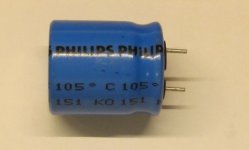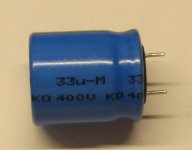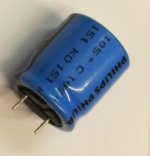Hi all,
I bought a cheap Chinese amp kit that has been around for a long time. About 4 years ago, it was advertised with "used tested good" Philips caps in the power supply. Who knows what that meant. Today I got one with a 33uF 400V capacitor made by Philips. It's supposed to be a 22uF (C3 on schematic).
Does anyone have any idea how old this cap might be and whether I should just spend a few bucks and replace it before I build the kit? Schematic and cap photos attached.
I bought a cheap Chinese amp kit that has been around for a long time. About 4 years ago, it was advertised with "used tested good" Philips caps in the power supply. Who knows what that meant. Today I got one with a 33uF 400V capacitor made by Philips. It's supposed to be a 22uF (C3 on schematic).
Does anyone have any idea how old this cap might be and whether I should just spend a few bucks and replace it before I build the kit? Schematic and cap photos attached.
Attachments
The date code on the capacitor is KO. Philips marks their capacitors with a date code
according to IEC 62. This date code repeats every 20 years. So the capacitors are
either October 2018, or October 1998.
according to IEC 62. This date code repeats every 20 years. So the capacitors are
either October 2018, or October 1998.
There is a guide floating around showing which manufacturer uses which stamping pattern on the metal top. Not to say that can't easily be faked but I found it interesting. Can't seem to locate it because google is terrible for this type of thing anymore. Maybe someone recalls where it was posted?
The date code on the capacitor is KO. Philips marks their capacitors with a date code
according to IEC 62. This date code repeats every 20 years. So the capacitors are
either October 2018, or October 1998.
Yeah ... probably better to spend 5 bucks to replace it. The rest are all "Vishay BC" and who knows how old those are. We are talking about a $320 Chinese amp kit, so I don't expect the highest quality parts. However, it's nice for something to not blow up in a year if I can prevent it. If I'm going to the trouble to build it, a few bucks for a few better parts is worth it.
I will say that the 450V caps I put in my Dynaco ST70 series ii when I gutted it in the 1990's (shortly after I bought it) are still just fine after 20 years of use followed by sitting on the closet shelf since then. I just dusted it off and tried it last week.
Anyone interested in this Chinese amp kit and the build, I have a general thread here:
https://www.diyaudio.com/community/...re-i-build-maybe-during-if-i-do.394962/page-4
Thanks.
I will say that the 450V caps I put in my Dynaco ST70 series ii when I gutted it in the 1990's (shortly after I bought it) are still just fine after 20 years of use followed by sitting on the closet shelf since then. I just dusted it off and tried it last week.
I probably ought to replace those ... about 30 years later. They were top quality and way over spec when I did it, but they are electrolytic ... and old. They do work though.
The date code on the capacitor is KO. Philips marks their capacitors with a date code
according to IEC 62. This date code repeats every 20 years. So the capacitors are
either October 2018, or October 1998.
I'll bet it is 1998. The other caps are all branded Vishay BC. Doing some reseach, I found these tidbits:
BC components, a leading manufacturer of passive electronic components, emerged from Philips Electronics Components division in January 1999. Vishay acquired BC components in December 2002. The former BC components product portfolio is now divided into Vishay Beyschlag and Vishay BC components.
Instead of using a new 22uF 400V, I'll bet they had boxes of these old Philips 33uF 400V sitting around forever and wanted to get rid of them. If they were 2018 production, they would be marked Vishay BC like all of the others in the kit since Vishay had taken over 16 years prior. Given the history of the kit being sold with "used tested good" Philips power supply capacitors, it makes me even more concerned that this one is in fact 1998, so I will spend a few bucks to replace it.
Test them. Apply working voltage through an ammeter to test for leakage. Also check ESR and capacitance. A high C reading indicates a cap could be on it's last legs. You could also try reforming them: an hour or two on a current limited & monitored PSU and they may reform.
In my experience the larger Philips caps are mostly ok but smaller values tend to need replacing.
Andy.
In my experience the larger Philips caps are mostly ok but smaller values tend to need replacing.
Andy.
It is in all liklihood a 1998 capacitor, and I can replace it for $4. It's not worth the risk. I have to order a few other small components anyway, so I already have to pay the $8 shipping cost. For $4 I'll simply toss it in the trash can.
Can't you just try it out? Do they look in good condition? Many multimeters measure capacitance, and if it gets warm in use then that is a sign the ESR is too high. I have used caps like that in a recent build.
The main issue with electrolytics is that they dry out with long term use, especially if stressed by operating at the limits of their ratings (especially temperature). An unused electrolytic loses some of its ability to be a capacitor due to the chemistry of the aluminium foil and the fluid they contain, but they regain the oxide layer they need once they have been used. There were severe quality problems with the manufacture of some electrolytic capacitors in the early 2000's from some companies, but that seems to have created a lot of myths about the general ability of electrolytics to be useful after a few years.
Order a replacement and you have a spare if the other one is OK.
The main issue with electrolytics is that they dry out with long term use, especially if stressed by operating at the limits of their ratings (especially temperature). An unused electrolytic loses some of its ability to be a capacitor due to the chemistry of the aluminium foil and the fluid they contain, but they regain the oxide layer they need once they have been used. There were severe quality problems with the manufacture of some electrolytic capacitors in the early 2000's from some companies, but that seems to have created a lot of myths about the general ability of electrolytics to be useful after a few years.
Order a replacement and you have a spare if the other one is OK.
Many multimeters measure capacitance
Yes, I just ordered one to replace my very old Radio Shack multimeter that doesn't test capacitance.
- Home
- Amplifiers
- Tubes / Valves
- Philips 33uF 400V cap age?


